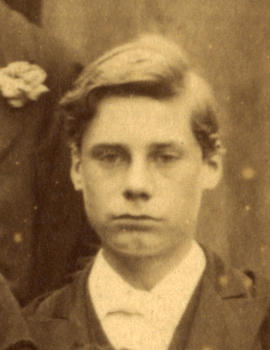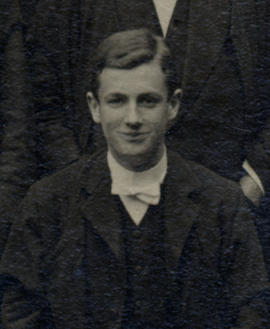Summerhays, Dudley Leycester, brother of Reginald Sherriff Summerhays (q.v.); b. Feb. 13, 1889; adm. Sept. 25, 1902 (H); left Easter 1908; enlisted in 5th Batt. East Surrey Regt. in 1914; 2nd Lieut. 9th Batt. London Regt. Dec. 9, 1914; went out to the western front Nov. 4, 1914; killed in action on Hill 60, near Ypres, Flanders, April 21, 1915; unm.
International Relations and Conflicts
393 People & Organisations results for International Relations and Conflicts
Stuttaford, Michael Charles, son of Charles Stuttaford and his second wife Nora Porter; half brother of Cyril Stuttaford (qv); b. 29 Sept. 1918; adm. Sept. 1932 (A); left July 1937; Merton Coll. Oxf., matric. 1937 (postmaster); Bombardier RA; d. 6 June 1944 in Palembang p.o.w. camp, Sumatra.
Michael Charles Stuttaford was born at Hampstead, London on the 29th of September 1918 the elder son of Charles Stuttaford, a gentleman, and his second wife, Nora Kathleen (nee Porter) Stuttaford of 34, Belsize Park Gardens, Hampstead. He was christened at All Saints Church, Knightsbridge on the 21st of November 1918. He was educated at Westminster School where he was up Ashburnham from September 1932 to July 1937 where he won the Marshall Memorial Prize (Class VI) in 1935 and was a member of the Fencing team in 1936. He matriculated for Merton College, Oxford on a Postmastership in 1937 from where he where he graduated with a BA. Has Captain of the Oxford University Fencing Team in 1940.
He enlisted as a Gunner in the Royal Artillery and was rose to the rank of Bombardier.
He was captured by the Japanese at Tasikmalaya, Java on the 8th of March 1942 following the surrender of the Allied forces there.
He died at Palembang in Sumatra.
He is commemorated on the war memorial at Merton College, Oxford.
He is buried at Jakarta War Cemetery Plot 4, Row A, Grave 13.
Street, Frank, brother of Henry Branson Street (q.v.); b. May 31, 1870; adm. as Q.S. June 12, 1884; elected to Ch. Ch. Oxon. July 1889, matric. Oct. 11, 1889; B.A. 1894; played football (Assoc.) for Oxford 1891-3; Capt. 1893; asst. master, Bury St. Edmunds School, 1894, Forest School 1895-9, Uppingham School from 1900; played cricket for Essex 1898 and 1899; enlisted in the 18th (Service) Batt. Royal Fusiliers Sept. 1914; Lieut. Jan. 1, 1915; went out to the western front Nov. 1915; m. April 22, 1911, Marian Willoughby, elder daughter of H. F. W. Greenhill, of Canada; killed in action at Ovillers, France, July 7, 1916.
Strain, John Loudon, eldest son of William Loudon Strain, M.B., of Wimbledon, by Dorothy Maud, daughter of the Rev. Ernest Lloyd Savory, of Stowmarket, Suffolk; b. Aug. 20, 1896; adm. Sept. 22, 1910 (A); elected to Trin. Coll. Camb. (with Samwaies) July 1915, matric. Michaelmas 1915; 2nd Lieut. R.G.A. (Spec. Res.) Dec. 17, 1915; acting Capt. May 24, 1917; went out to the western front Sept. 1916; killed in action at Frezenberg, Flanders, July 31, 1917.
Strain, Alan Gordon, brother of John Loudon Strain (qv); b. 1 Dec. 1914; adm. Jan. 1928 (A); left July 1933; Caius Coll. Camb., matric. 1934, BA 1937; Sgt Army Educational Corps; d. on active service 10 Aug. 1943.
Alan Gordon Strain was born at Kingston-upon-Thames, Surrey on the 1st of December 1914 the fifth and youngest son of Dr. William Loudon Strain MD CM and Dorothy Maud (nee Savory) Strain of 4, Hove Court, Raymond Road, Wimbledon in Surrey. He was educated at Westminster School where he was up Ashburnham from January 1928 to July 1933. He matriculated for Gonville and Caius College, Cambridge in 1934 and was awarded a BA in 1937. On leaving university he went to work as a school teacher at Collington Rise Preparatory School, Bexhill-on-Sea in Sussex.
He enlisted in the Army Educational Corps where he rose to the rank of Sergeant. He was taken ill and was in a hospital at Epsom for three months before he died.
His brother, Captain John Loudon Strain OW, Royal Garrison Artillery, was killed in action on the 31st of July 1917.
He is buried at Putney Vale Cemetery and Crematorium Block I, Grave 363.
Storrs, Henry Lionel, second son of the Rev. Harry Townsend Simonds Storrs, Rector of East Bergholt, Essex, by Clara Fanny, daughter of Lieut.-Col. James Robert Sale Henderson, Madras Staff Corps; b. May 18, 1898; adm. as K.S. Sept. 26, 1912; elected to Trin. Coll. Camb. (with Triplett and Samwaies) July 1916, but did not matric.; 2nd Lieut. R.F.C. Aug. 28, 1916; Lieut. Feb. 28, 1918; acting Flight-Commander; went out to the western front Jan. 1917; d. at the Duchess of Sutherland's Hospital, near Arras, June 20, 1918, of wounds received in action near Ypres, Flanders, June 15.
Stone, Herbert William Degetan, brother of Waldemar Ernest Smith (q.v.); b. May 26, 1879; adm. Sept. 22, 1892 (H); exhibitioner 1893; Q.S. (non-resident) 1894; left July 1896; a clerk in the London and Westminster Bank, and in 1898 entered a marine insurance business in Shanghai; returned to London in Aug. 1913; enlisted in the Royal Fusiliers (U. and P.S. Batt.) Dec. 10, 1914; 2nd Lieut. 4th Batt. (Extra Reserve) Connaught Rangers May 26, 1915; went out to the western front in Dec. 1915, and was attached to the Royal Irish Rifles; assumed the surname of Stone in lieu of Schmidt May 5, 1915; killed in action at Mont St. Eloi April 26, 1916.
Stoddart, George Benjamin Johnstone, stepson of William Henry Butter Stoddart, M.D., of St. Marylebone; b. July 21, 1899; adm. Sept. 28, 1911 (A); left July 1914; assumed the additional surname of Stoddart; enlisted in the 2nd Dragoon Guards (Queen's Bays) Sept. 1, 1914; attached 6th Inniskilling Dragoons, M.G. Section; served in France May 1915 -Jan. 1916, when he was recommended for a commission, but being under age was returned to England; 2nd Lieut. R.A.F. Oct. 25, 1917; Flying Officer Jan. 25, 1918; went out again to the western front April 6, 1918; killed accidentally while flying near Picquigny April 10, 1918.
Stickland, John Robert Antony, son of George Cuthbert Stickland, Egyptian Education Service, and Kathleen Mary, d. of J. A. Fossick of Gloucester; b. 17 June 1921; adm. Sept. 1934 (H); left July 1939; Cadet RN 1939, Sub-Lieut. RNVR June 1942, Lieut. Dec. 1943; killed in action Mar. 1944 in the loss of HMS Gould.
John Robert Antony Stickland was born at Fulham, London on the 17th of June 1921 the only son of George Cuthbert Stickland, Egyptian Education Service, and Kathleen Mary (nee Fossick) Stickland of “Sydenham”, Lewdown in Devon. He was educated at Westminster School where he was up Homeboarders from September 1934 to July 1939. He was a member of the Photographic Society and was elected as Secretary of the Natural History Society in 1938.
On leaving school he entered the Royal Naval Volunteer Reserve as a Special Entry Cadet on the 1st of September 1939 and was appointed as a Midshipman on the 31st of October 1940. He was commissioned as a Sub Lieutenant in June 1942 and was promoted to Lieutenant in December 1943. He was posted to the frigate HMS Gould (K476).
On the 29th of February 1944, HMS Gould, under the command of Lieutenant Daniel William Ungoed RN, was on convoy escort duty when she was one of four frigates which located the U Boat U-358, under the command of Kapitänleutnant Rolf Manke, when some 450 miles to the north, north east of the Azores. In a series of attacks on the U Boat, which lasted throughout the night, the four ships dropped a total of 104 depth charges. The next day two of the frigates left for Gibraltar leaving HMS Gould and the frigate HMS Affleck (K362) to continue the pursuit of the enemy submarine. After 38 hours underwater and having been under continuous depth charge attacks, U-358 was forced to the surface at 7.20pm where she managed to fire a G7e “Gnat” torpedo from her rear tube which struck HMS Gould in the aft motor room at 7.21pm. The explosion broke her in two, with the stern section sinking very quickly. The forward section capsized and sank twenty five minutes later following a heavy list to starboard. Seven officers and one hundred and sixteen ratings were killed in the attack.
HMS Affleck closed with the U Boat at full speed and with all guns firing, scoring hits on the conning tower and on the hull of the enemy submarine. She then attacked with depth charges at close range and, after an explosion which broke the back of the U Boat, it sank at 7.39pm with only one survivor from its crew being picked up and taken prisoner. The frigate then rescued three officers and thirty two ratings from HMS Gould before taking them to Gibraltar. One rating died from his wounds during the journey and was buried at sea the following day.
His parents received the following telegram: - “From Admiralty. Deeply regret to inform you that your son Lieutenant J.R.A. Stickland RNVR has been reported missing presumed killed on active service. Letter follows shortly.”
He is commemorated on the war memorial at Lewdown.
He is commemorated on the Plymouth Naval Memorial Panel 92, Column 3.
Stewart, Charles Duncan Stuart, son of Col. Charles Victor Stewart OBE MC RE, architect, of Sidcup, Kent; b. 19 Apr. 1918; adm. Sept. 1931 (A); left July 1932; Sgt Pilot Bomber Command RAF; killed in action Jan. 1942.
Charles Duncan Stuart Stewart was born at Kensington, London on the 19th of April 1918 the elder son of Colonel Charles Victor Stewart OBE, MC, Royal Engineers, later an architect, and Doris Stuart (nee Kettelwell) Stewart of 12, Cottesmore Gardens, Kensington. He was educated at Westminster School where he was up Ashburnham from September 1931 to July 1932.
He enlisted in the Royal Air Force Volunteer Reserve where he trained as a pilot and rose to the rank of Sergeant.
On the night of the 25th/26th of January 1942, Bomber Command dispatched 61 aircraft to attack enemy warships in Brest Harbour. 49 Squadron dispatched seventeen aircraft for the raid and they began taking off at 4.50pm. When they arrived over the target it was found to be covered by 10/10th cloud with most of the aircraft attacking alternate targets in the area of the docks, while eight returned without making an attack at all. All the aircraft returned to base.
Charles Stewart and his crew took off from RAF Scampton at 5.12pm on the 25th of January 1942 in Hampden AT129 EA-O for the operation. The aircraft was carrying a load of bombs and pyrotechnics. At the time, he had accumulated 238.20 hours of total solo flying time of which 159.20 were on Hampden aircraft. Two minutes after lifting off the aircraft crashed to the west of the airfield at the hamlet of Bransby, between the villages of Sturton and Saxilby at 5.10pm killing the entire crew.
The crew was: -
Sergeant Charles Duncan Stuart Stewart (Pilot)
Sergeant Albert Hibbet (Air Gunner)
Sergeant Kenneth Edward Northrop (Observer)
Sergeant Leonard Arthur Jardine (Wireless Operator/Air Gunner)
It is thought that the cause of the crash was due to ice having collected on the flying surfaces.
His funeral took place on the 31st of January 1942.
The crew are commemorated on a memorial in a wooden shelter at the Bransby Equestrian Centre.
He is buried at Sutton Cemetery, Section B, Grave 35.


